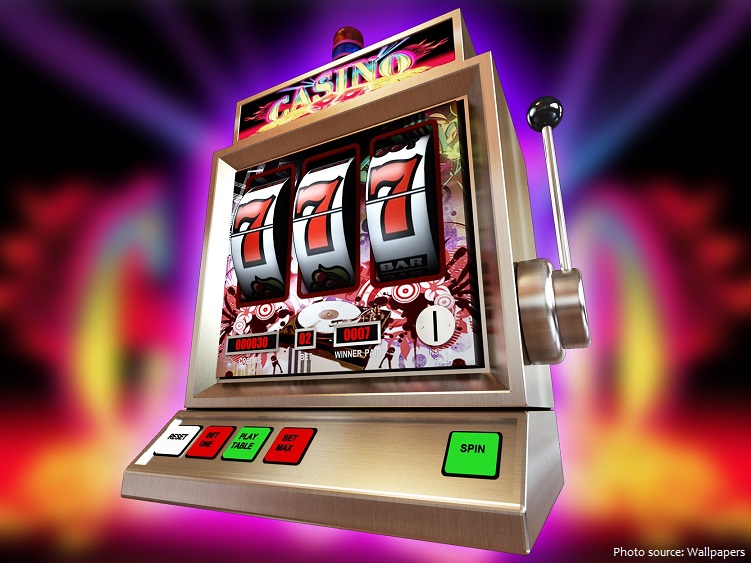
A slot machine is a gambling machine that creates a game of chance for its customers.
They are called also fruit machine (British English) or poker machine (Australian English and New Zealand English) and have a nickname one-armed bandits because of the large mechanical levers affixed to the sides of early mechanical machines and the games’ ability to empty players’ pockets and wallets as thieves would.
The “slot machine” term derives from the slots on the machine for inserting and retrieving coins. “Fruit machine” comes from the traditional fruit images on the spinning reels such as lemons and cherries.
The gambling device operated by dropping one or more coins or tokens into a slot and pulling a handle or pushing a button to activate one to three or more reels marked into horizontal segments by varying symbols.
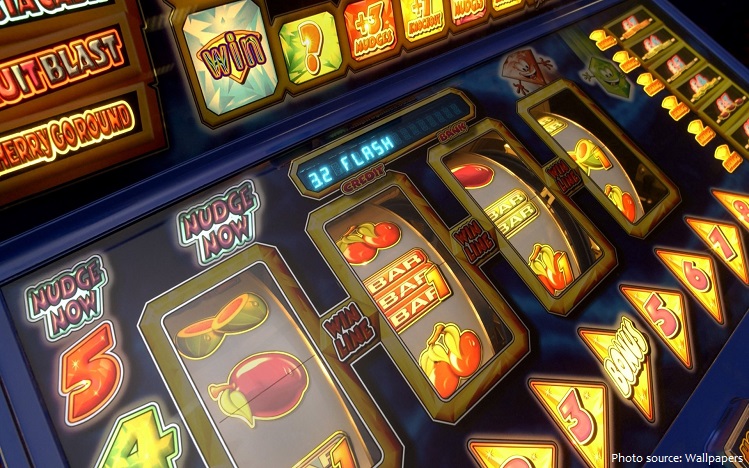
The machine pays off by dropping into a cup or trough from two to all the coins in the machine, depending on how and how many of the symbols line up when the rotating reels come to rest.
Symbols traditionally used include stars, card suits, bars, numbers (7 is a favourite), various pictured fruits—cherries, plums, oranges, lemons, and watermelons—and the words jackpot and bar.
The first coin-operated gambling devices in the United States date to the 1880s, although they were actually mere novelties—such as two toy horses that would race after a coin was inserted in the machine—rather than direct gambling machines.
Sittman and Pitt of Brooklyn, New York developed a gambling machine in 1891 that was a precursor to the modern slot machine. It contained five drums holding a total of 50 card faces and was based on poker. The machine proved extremely popular, and soon many bars in the city had one or more of them.
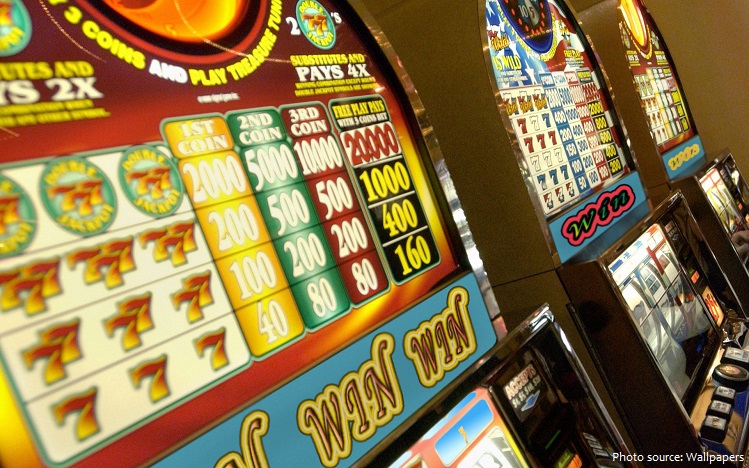
The first slot machine was invented by Bavarian immigrant Charles Fey of San Francisco in 1894. Fey built the 4-11-44 in his basement the following year – it proved so successful at a local saloon that he soon quit his job and opened a factory to produce more units.
In 1898 Fey built the Card Bell, the first three-reel slot machine with automatic cash payouts. The Card Bell had a handle that set the reels in motion when it was pushed down and playing card suitmarks that lined up to form poker hands.
His next slot machine, the Liberty Bell, was built in 1899 and used horseshoes and bells as well as playing card suitmarks on the reels. Three bells lined up in a row meant the top payout. Chiefly because of the 1906 San Francisco earthquake, only 4 of more than 100 Liberty Bell machines built by Fey survive. The Liberty Bell proved immensely popular among saloon patrons in San Francisco and was quickly copied by Fey’s competitors, such as the Mills Novelty Company of Chicago.
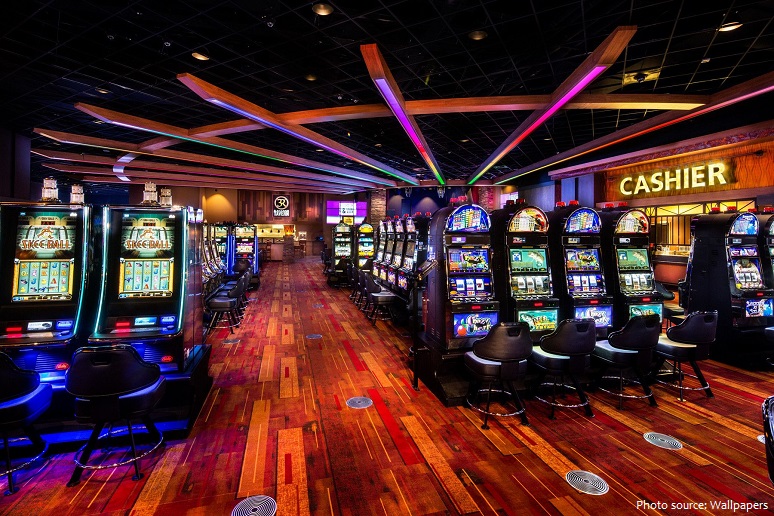
During the 1920s the machines were popular throughout much of the United States, especially in resort areas, and they continued to be popular into the Great Depression years of the ’30s. But knowledge that the distribution of slot machines was often controlled by organized crime led to increasing legislation restricting their sale and transportation as well as their use except in private social clubs. Prohibition outside Nevada, which had relegalized gambling in 1931, was virtually total by 1951, although illegal operation, especially in private clubs, was widely ignored.
In 1963, Bally developed the first fully electromechanical slot machine called Money Honey (although earlier machines such as Bally’s High Hand draw-poker machine had exhibited the basics of electromechanical construction as early as 1940). Its electromechanical workings made Money Honey the first slot machine with a bottomless hopper and automatic payout of up to 500 coins without the help of an attendant. The popularity of this machine led to the increasing predominance of electronic games, with the side lever soon becoming vestigial.

The first true video slot machine was developed in 1976 by Walt Fraley who called it the Fortune Coin. This slot machine used a modified 19″ Sony Trinitron color receiver for the display and logic boards for all slot machine functions. The prototype was mounted in a full size show-ready slot machine cabinet. The first production units went on trial in Las Vegas. After that it was just a matter of time when technology also allowed the linking of multiple slot machines in multiple sites. The first progressive slot machine, called Megabucks, were invented in 1986 by the slot manufacturing company IGT.
The advent of the internet in the 1990s coupled with faster and more powerful computers brought about the world of online slots. Today, online casinos reach a worldwide population of gamers bringing the fun of slot machines into anyone’s home. Modern digital slot machine design and game play is limited only by the imagination of the developers. Software providers are constantly pushing the boundaries in their quest for the most exciting, fun and original slot machines.
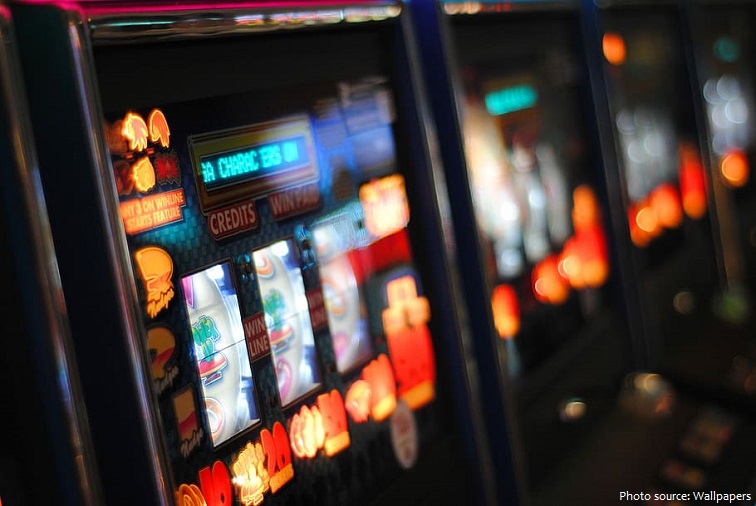
The largest slot machine payout is $39,713,982.25 (£25,361,761) won by a 25-year-old software engineer from Los Angeles after putting in $100 (£64) in the Megabucks slot machine at the Excalibur Hotel-Casino, Las Vegas, Nevada, USA on 21 March 2003.
The most slot machines running the same game simultaneously was 1,610, achieved by Bally Technologies (USA) at Mohegan Sun Montville, Connecticut, USA, on 27 April 2013.
The largest slot machine tournament involved 3,173 participants in an event organized by Muckleshoot Casino with support from Everi Games Inc. (both USA), in Auburn, Washington, USA, on 30 April 2016.